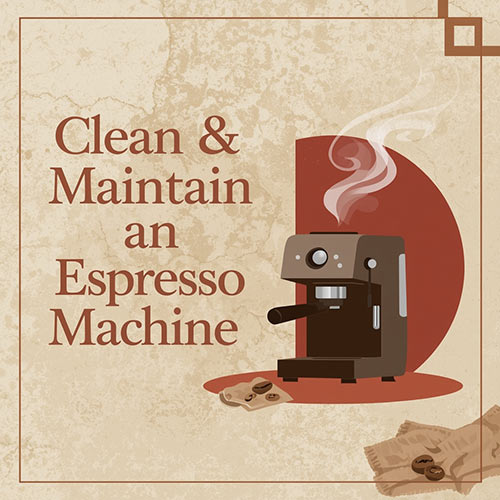How to Properly Clean & Maintain an Espresso Machine
If you’re serious about making great coffee, learning how to properly clean & maintain an espresso machine isn’t just a chore — it’s a skill that will protect your investment and keep every cup tasting fresh. An espresso machine is like the heart of your home or café setup. Neglect it, and you’ll end up with bitter coffee, costly repairs, or even a broken machine. Care for it, and it will reward you with years of rich, aromatic shots.
In this guide, we’ll walk you step-by-step through the cleaning process, share maintenance routines, and reveal pro tips to keep your espresso machine in top condition.
Why Cleaning & Maintenance Matters
A sparkling espresso machine isn’t just about looks — it’s about taste, performance, and longevity. When oils, coffee grounds, and mineral deposits build up:
- Your espresso can taste burnt or sour.
- Water flow can be blocked, leading to uneven extraction.
- Internal parts wear out faster, resulting in expensive repairs.
Think of it like brushing your teeth: you wouldn’t skip it for weeks, right? The same principle applies here.
Step 1: Daily Cleaning Routine (After Every Use)
Daily cleaning is the single most important habit for anyone learning how to properly clean & maintain an espresso machine.
Here’s your daily checklist:
- Purge the Steam Wand After Every Use
- Right after steaming milk, wipe the wand with a clean, damp cloth.
- Purge steam for 2–3 seconds to clear milk residue from inside.
Pro Hack: Keep a separate microfiber cloth just for the steam wand to avoid cross-contamination.
- Rinse the Portafilter and Basket
- Knock out used coffee grounds, rinse under hot water, and wipe dry.
- Avoid using soap daily, as it can affect flavor; just ensure there’s no coffee oil buildup.
- Run a Short Water Flush Through the Group Head
- This removes coffee particles from the screen and keeps water flow consistent.
- Empty and Rinse the Drip Tray & Water Tank
- Stale water and residue can cause odors and bacterial growth.
Step 2: Weekly Deep Cleaning
Daily cleaning keeps things running smoothly, but once a week, it’s time for a deeper clean.
Weekly tasks include:
- Backflushing with Detergent (for machines with a 3-way solenoid valve)
- Insert a blind filter basket into your portafilter.
- Add half a teaspoon of espresso machine cleaner.
- Run the pump for 10 seconds, then stop for 10 seconds — repeat 5 times.
- Rinse thoroughly by backflushing with clean water several times.
- Soak Portafilter, Baskets, and Shower Screen
- Use warm water with espresso cleaner to dissolve oils.
- Rinse thoroughly before use.
- Clean the Steam Wand Tip
- Unscrew the tip and soak it in hot water with a little cleaning solution.
- This prevents milkstone buildup, which can clog steam flow.
Step 3: Monthly Maintenance
Monthly maintenance is about going beyond the surface and addressing hidden build-ups.
- Descaling the Machine (especially if you live in a hard-water area)
- Use a manufacturer-recommended descaling solution.
- Fill the water tank with the solution, run it through the machine, and then flush several tanks of fresh water to remove all residue.
Pro Hack: If possible, use filtered water daily to slow mineral buildup.
- Check Gaskets and Seals
- Group head gaskets wear out over time. If you see water leaking around the portafilter, it’s time for a replacement.
- Inspect Grinder Burrs (if your grinder is built into the machine)
- Dull burrs produce uneven grounds, affecting espresso flavor.
Step 4: Seasonal or Bi-Annual Care
If you want your espresso machine to last for years, schedule more thorough maintenance twice a year.
- Replace Group Head Gasket & Shower Screen
- Even with regular cleaning, these parts degrade and affect water dispersion.
- Lubricate Moving Parts (if your machine’s manual recommends it)
- Food-safe lubricant can extend the life of levers, knobs, and mechanical linkages.
- Full Internal Descale & Inspection
- Especially for commercial use, you should have a professional service check internal parts, pressure levels, and temperature calibration.
Common Mistakes to Avoid
Even well-intentioned owners make errors that shorten the life of their machine.
- Skipping Backflushing – This is the #1 reason group heads get clogged.
- Using Tap Water in Hard-Water Areas Leads to rapid scale buildup.
- Forgetting to Purge the Steam Wand – Dried milk inside can be nearly impossible to remove.
- Overusing Descaling Solutions – Can damage internal parts if done too frequently.
Pro Hacks for Espresso Machine Care
- Use Two Towels – One for wiping milk residue and one for cleaning coffee parts.
- Pre-Heat Before Cleaning – Warm water dissolves coffee oils faster.
- Label Cleaning Supplies – Keep your machine’s cleaning brush, detergent, and cloths separate from general kitchen items to avoid cross-use.
- Create a Cleaning Schedule – Post it near your machine so staff or family members follow the same steps.
Tools & Supplies You’ll Need
- Blind filter basket
- Espresso machine cleaning powder/tablets
- Food-safe descaler
- Steam wand cleaning brush
- Microfiber cloths
- Water filter (if applicable)
Final Thoughts
Mastering how to properly clean & maintain an espresso machine is a habit that pays off daily — with fresher flavors, smoother performance, and fewer breakdowns. Think of it as part of your coffee ritual. A clean machine not only produces better espresso but also tells everyone who drinks your coffee that you care about quality.
Whether you’re a home enthusiast or running a busy café, the secret to consistent, café-quality shots isn’t just skill — it’s a machine that’s been cared for like a trusted teammate. Clean it well, maintain it regularly, and it will reward you cup after cup.

